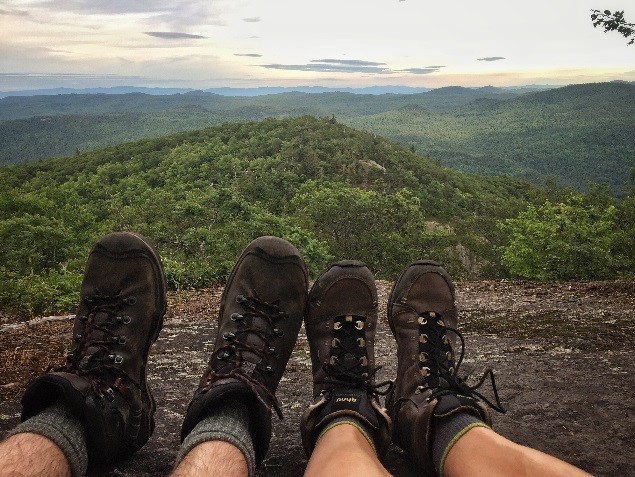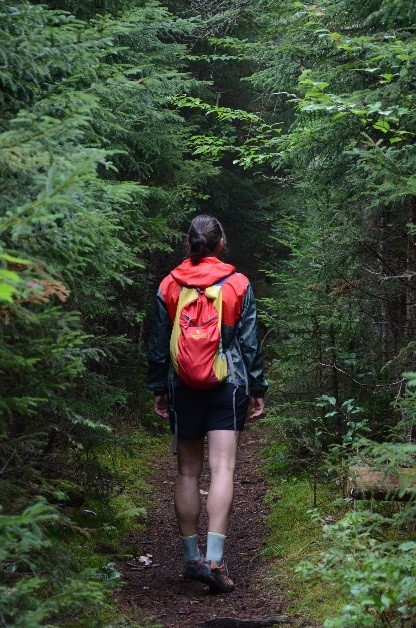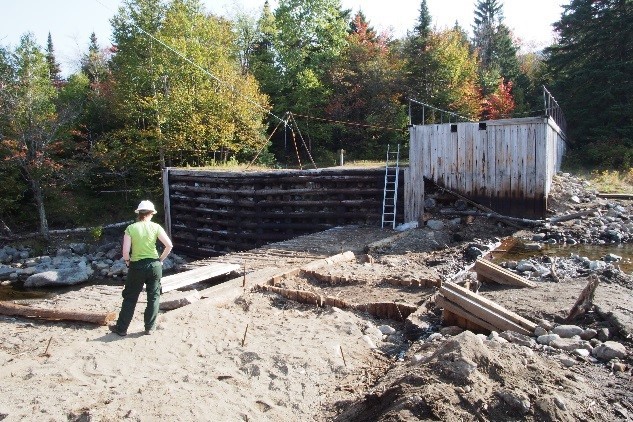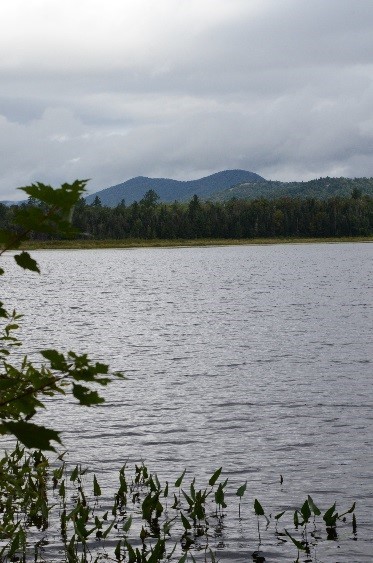|
Have a safe and enjoyable outdoor recreational experience on the lands and waters of the Adirondacks. Properly plan and prepare for your outdoor adventure. Minimize the impact on the mountains and forests, rivers and brooks, ponds and lakes, and the wildlife of the Adirondacks.
Check the Backcountry Information for the Adirondacks web pages for more detailed information on access, outdoor recreation infrastructure, and conditions for those planning to recreate in the Adirondacks. This bulletin provides only the most recent notices.
Emergency Situations: If you get lost or injured; keep calm and stay put. If you have cell service, call the DEC Forest Ranger Emergency Dispatch (518-891-0235).
More information on hiking safety and what to pack.
Bear Activity: Bear canisters are currently required in the High Peaks Wilderness and strongly recommended throughout the rest of the park. Be sure all of your food and waste will fit securely within the bear canister. If you’re not sure about an item, pack it in your canister anyway.
Plan
Weather forecas ts and conditions can and do change quickly. Check the current National Weather Service Forecast and be prepared for the forecasted conditions or change your plans. ts and conditions can and do change quickly. Check the current National Weather Service Forecast and be prepared for the forecasted conditions or change your plans.
-
Plan for shorter days. As fall quickly approaches, the days continue to get shorter. Plan your hike accordingly to ensure you have plenty of daylight for your trip. Pack a headlamp and extra batteries with you on all hikes.
-
Plan for much cooler temperatures on summits and exposed areas. Protect yourself from hypothermia by packing extra non-cotton, warm and wind protectant layers.
-
Temperatures in the Adirondacks are reaching near freezing at night. Campers and evening hikers should prepare for extreme temperature changes as the sun sets. Pack appropriately to protect yourself from hypothermia.
Prepare
Properly prepare to better ensure a safe and enjoyable recreation experience.
-
Prevent Hypothermia: Dress properly, stay dry and add or remove layers to regulate your body temperature. Carry plenty of food and water. Eat, drink and rest often. Being tired, hungry or dehydrated makes you more susceptible to hypothermia.
-
If you get lost or injured; keep calm and stay put. If you have cell service, call the DEC Forest Ranger Emergency Dispatch (518-891-0235). Try to stay warm and dry by separating yourself from the ground by sitting on your pack or an extra layer. Build a campfire to provide heat, light and comfort. A campfire will also be useful for search crews to locate you. See Emergency Essentials Packing below.
Practice Leave No Trace
 Follow proper trail etiquette to maintain minimal impact on the environment and the natural resources of the Adirondacks, as well as ensure an enjoyable outdoor experience for all visitors by following the Seven Principles of Leave No Trace. Follow proper trail etiquette to maintain minimal impact on the environment and the natural resources of the Adirondacks, as well as ensure an enjoyable outdoor experience for all visitors by following the Seven Principles of Leave No Trace.
Plan Ahead and Prepare - Emergency Essentials
- Keep an emergency essentials kit in your pack. A few things to include are: a pocket knife, duct tape to patch ripped jackets or broken poles, a headlamp for unexpected trips out in the dark or overnight stays, space blanket, emergency whistle, first aid kit, fire making tools, extra layers and socks.
Be Considerate of Other Visitors
- Be courteous of others while recreating regardless of their activity, speed or skill level. Hike in single file, especially when approaching other hikers. Stay to the right and pass on the left when safe and appropriate. Allow faster hikers to pass. When approaching other hikers from behind, politely let them know of your presence and desire to pass.
Dispose of Waste Properly
- To wash your dishes, carry water 200 feet away from streams or lakes, and use small amounts of biodegradable soap. Strain the dishwater, then broadcast, or scatter over a wide area 200 feet away from camp. Pack out any food scraps collected in the strainer, in order to avoid impacting wildlife in the area.
- Solid human waste should be packed out. If packing human waste out is not an option, dig a cathole 6-8 inches deep at least 200 feet away from travel routes and water sources. Choose a sunnier area to help breakdown waste faster. Cover and disguise cathole when finished.
General Conditions/Notices
Learn the conditions you will encounter from Adirondack Backcountry Information.
All
-
Late Summer Weather:
- This weekend, daytime temperatures are forecast to be in the 70s and low 80s, but night time temperatures will be in the 40s and low 50s.
- The sun is setting earlier and rising later. Be sure to carry a flashlight or headlamp and extra batteries.
- Campers should pack extra layers of clothing, a winter hat, and gloves.
-
Biting Insects: Mosquitoes, stable flies, and no-see-ums (biting midges) are still present but in fewer numbers. Follow these steps to minimize the nuisance of biting insects:
- Wear light colored clothing.
- Wear long sleeve shirts; tuck shirts into pants and button or rubber band sleeves at the wrist.
- Wear long pants and tuck the bottom of pant legs into your socks.
- Pack a headnet to wear when insects are thick.
- Use an insect repellant with DEET. Follow label directions.
-
Fire Danger Rating: Low. Check the current fire danger map. DEC Forest Rangers continue to respond to wildland fires started by unattended or improperly extinguished campfires. Be safe with campfires.
Hikers and Campers
-
 Trail Conditions: Trails may be muddy in some locations – especially in low spots, along water bodies, and in drainages. Avoid damaging hiking trails, trail side vegetation and habitats. Trail Conditions: Trails may be muddy in some locations – especially in low spots, along water bodies, and in drainages. Avoid damaging hiking trails, trail side vegetation and habitats.
- Wear water-resistant hiking boots and let them get muddy.
- Stay in the center of trail and walk through mud and water.
-
Active Nuisance Bears: The warm dry weather has reduced the amount of berries and other natural foods available to bears. DEC has received reports of nuisance bears throughout the Adirondacks. Follow practices to avoid negative encounters with bears in the backcountry.
-
Bear Resistant Canisters: The use of bear-resistant canisters is required for overnight users in the Eastern High Peaks Wilderness between April 1 and November 30. All food, toiletries and garbage must be stored in bear-resistant canisters. DEC encourages the use of bear-resistant canisters throughout the Adirondacks.
-
Stream Crossings: Use caution around steep, shallow, rocky streams and rivers. These are considered “flashy”, meaning water levels can rise quickly after heavy rainfall. Water levels will also drop quickly after the rains have stopped.
-
Mountain Summits: Temperatures will be cooler and winds will be stronger. Check the National Weather Service Mountain Point Forecasts for selected summits.
Boaters, Paddlers and Anglers
-
Water Levels: Despite some recent rain, water levels in most streams, rivers, lakes and ponds are low to very low. See the USGS Current Water Data for New York for stream flow of selected waters.
- Boaters and paddlers should be alert for objects on or below the surface that are typically covered by deeper water.
- Many shallow sections of rivers cannot be traversed by canoes or kayaks.
Mountain Bikers
-
Electric bicycles: Electric bicycles (E-bikes) of any class are not allowed on trails or roadways where public motorized access is prohibited.
Recent Notices
Notices below reflect recent changes in conditions and recreation infrastructure work completed by DEC and its partners. See Backcountry Information for the Adirondacks web pages for ongoing issues and more detailed information.
-
Saranac Lake Wild Forest:
-
Boreas Ponds Tract: Gulf Brook Road is closed during the week while DEC completes ditching and repair work on the portion of the road between the Fly Pond Gate and the Four Corners. The road will be open to public motor vehicle access each weekend from 5 p.m. Friday through sundown on Sunday.
-
 High Peaks Wilderness: High Peaks Wilderness:
- SCA Adirondack Corps will be working on the Marcy Dam removal project beginning Monday, 9/10 with a planned completion date of Wednesday 9/19. Hikers are asked to stay away from rigging areas and follow flagging and signage for minor detours around the work site. This is the 4th year of a 5-year project to lower the dam spillway and allow Marcy Brook to return a natural condition.
- Nuisance bear activity has subsided in the Eastern High Peaks. However, hikers and campers should still follow practices to avoid negative encounters with bears. Pack all food, toiletries and garbage in a bear resistant canister as required by regulation.
- The lands of the former Dix Mountain Wilderness are now part of the High Peaks Wilderness.
- DEC will be changing signs, web pages, and regulations to eliminate the Dix Mountain Wilderness and transition to the High Peaks Wilderness.
- Group size regulations are now in effect on the lands in the former Dix Mountain Wilderness. Groups should consist of no more than 15 hikers and no more than 8 campers.
- DEC is undertaking a multi-year, comprehensive effort to promote sustainable tourism and address public safety in the Adirondacks focused on the State Route 73 Corridor between Exit 30 of the Northway (I-87) and Lake Placid.
-
Bog River Complex (Lows Lake)
- DEC is overseeing a maintenance project on the Lows Upper Dam to bring the dam into compliance with New York Dam Safety Regulations.
- Construction activities will impact recreational users of the portage from Hitchins Pond to Lows Lake, as well as private landowners and users of the Sabattis Boy Scout Camp.
- Work is scheduled to occur Monday through Friday and is expected to last through summer 2018.
- Members of the public wishing to access Hitchins Pond and Lows Lake will continue to launch at Low's Lower Dam, located near the end of State Highway 421.
- Recreational users should continue to use the existing designated portage around Low's Upper Dam.
- From Hitchins Pond travel northwest past the old homesite.
- Stay within the designated traffic area (delineated with orange construction fence) at all times as you make your way through the work area.
- Continue to the dock on the right side of the Bog River Flow.
- If you have any questions or concerns contact Henry Dedrick, Supervising Forester at the DECs Potsdam sub-office at 315-274-3342 or e-mail: information.R6@dec.ny.gov.
Highlighted Hike- Rock Lake Trail, Blue Mountain Lake, NY
 Rock Lake Trail, part of the Blue Mountain Wild Forest, extends 0.8 miles from the trailhead on State Route 28/30 to the shore of Rock Lake, dropping only 80 feet in elevation in that distance. Rock Lake is not only scenic, but provides paddling and fishing opportunities as well. The lake contains brook trout, smallmouth bass, and panfish. Rock Lake Trail, part of the Blue Mountain Wild Forest, extends 0.8 miles from the trailhead on State Route 28/30 to the shore of Rock Lake, dropping only 80 feet in elevation in that distance. Rock Lake is not only scenic, but provides paddling and fishing opportunities as well. The lake contains brook trout, smallmouth bass, and panfish.
There are three designated tent sites on the shore of Rock Lake, as well for primitive camping. All designated primitive tents sites, campsites and lean-tos are available on a first come - first served basis and cannot be reserved. Designated campsites are marked with a yellow "Camp Here" disc. Designated tent sites are for tents only. There are no hook-ups for water or electricity at campsites.
Rock Lake Trailhead and parking area is located on the east side of State Route 30 (43.8215°N, 74.3486°W).
|


 ts and conditions can and do change quickly. Check the current
ts and conditions can and do change quickly. Check the current  Follow proper trail etiquette to maintain minimal impact on the environment and the natural resources of the Adirondacks, as well as ensure an enjoyable outdoor experience for all visitors by following the
Follow proper trail etiquette to maintain minimal impact on the environment and the natural resources of the Adirondacks, as well as ensure an enjoyable outdoor experience for all visitors by following the  Trail Conditions: Trails may be muddy in some locations – especially in low spots, along water bodies, and in drainages. Avoid damaging hiking trails, trail side vegetation and habitats.
Trail Conditions: Trails may be muddy in some locations – especially in low spots, along water bodies, and in drainages. Avoid damaging hiking trails, trail side vegetation and habitats.
 High Peaks Wilderness:
High Peaks Wilderness:
 Rock Lake Trail, part of the
Rock Lake Trail, part of the